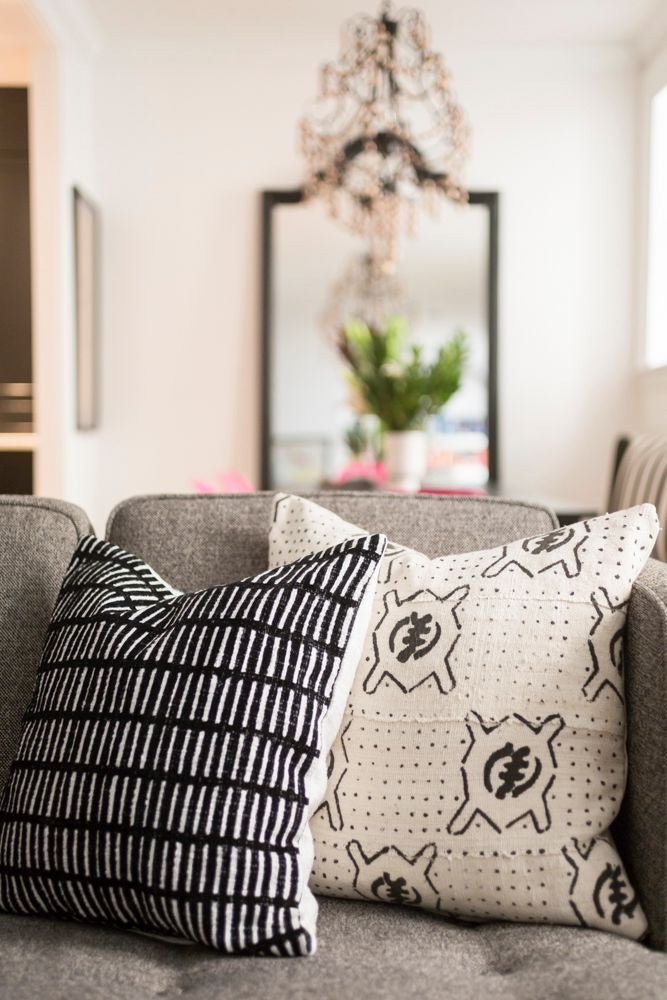how to make pillowcases without a sewing machine
7 alternative ways to cover your pillows.
Published Mar 28, 2016 5:00 AM
We may earn revenue from the products available on this page and participate in affiliate programs.
Pillows—and pillowcases—are expensive, which makes switching them up every season difficult. But don’t let that stop you! It’s actually super easy to DIY your own pillowcases. And MAJOR spoiler alert: You don’t even need a sewing machine. Really. Read on for seven ways to cover your pillows, no heavy machinery required.
no sew
You can literally wrap your already covered pillow (or pillow form) up like a burrito, meaning the only thing you have to purchase is fabric from your local craft store. You simply take a square of fabric, place the pillow towards one corner, wrap, tie, and you’re done!
(Here’s a more detailed video!)
iron adhesive
Yes, magic exists. Heat’n’Bond iron on adhesive tape makes it easy to essentially glue fabric together to create a seam. Warning: It’s not nearly as easy as folding your pillow into a square of fabric. There a quite a few more steps… But don’t let that deter you. This project is appropriate for a pillow you want covered for a longer time, not a temporary accent.
(For full instructions, visit Better Homes and Gardens)
needle and thread
Don’t let working with a needle and thread scare you. First, buying the two materials will cost you no more than a few dollars. Second, anyone can hand stitch. Sewing a pillowcase with a needle and thread is just like making one with a sewing machine, except you’ll obviously be sewing by and and it will take a few minutes longer. Don’t let the project intimidate you (and don’t expect perfection!).
(See a tutorial for making a three-piece cover here.)
with glue
If you haven’t caught on yet, you can use just about anything to secure the seam of the pillow. Even glue. Not any glue, though. Unique Stitch Adhesive reads “sewing with a tube” right on the bottle. (Another great option is Liquid Stitch.) The steps are the same as with any envelope pillow, except instead of stitching, you glue! Pro tip: Once you’ve applied the glue to each seam, make sure you allow your project to dry overnight.
(Check out Homey Oh My! for more information.)
with a zipper
Adding a zipper can spice things up a bit—and make it easier to insert and remove pillow forms. This is key for washing. The zipper will only be located along one seam, and most people opt to use a sewing machine, but that doesn’t mean you can’t hand sew it.
(Visit Hey There Home for all the steps.)
placemat pillow
This tutorial will actually blow your mind. Placemats are two-sided, so obviously tearing apart one seam, stuffing, and re-sewing (or gluing) makes sense. You’ll need to pick up a seam ripper—if you don’t already have one—to tear the stitching out. This project will most likely cost you around five dollars a pillow.
(See the entire process at Run To Radiance.)
velcro
Adding velcro complicates the process just a bit (like the zipper!), but it makes removal so much easier and is definitely worth adding a few more minutes to your DIY project. This tutorial also uses two dishtowels, which serves as a reminder that you can really use whatever cloth material you can get your hands on (and like, of course!).
(Check out In My Own Style for a more detailed tutorial.)
hot glue reupholstery
Recovering a pillow with hot glue isn’t a “pillowcase” per se, it’s really more of a reupholstery project with glue. So if you’re totally over your old pillow and have a hot glue gun laying around the house, this might be the method for you. It’s as easy as it sounds. You simply glue finished edges down around the seams of the pillow until it’s all covered.
(For step-by-step visuals, visit The Turquoise Piano.)
no sew hot glue
If you’re still attached to your old pillow or just want the flexibility of being able to remove your new cover, try this method. It’s a mix of a few techniques. First, you wrap your pillow as if you were looking to wrap it 100% no-sew style. But you’ve to secure the fabric somehow, so you simply hot glue fabric to fabric, which means cutting or tearing the pillowcase off is an option.
(View the full tutorial on Silver Pencils.)
